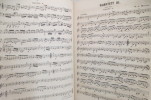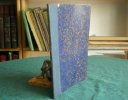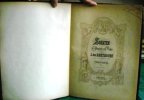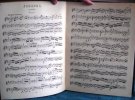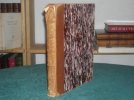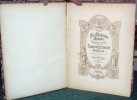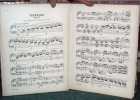468 books for « mendelssohn »Edit
-
Type
Book (463)
Disk (1)
Music sheets (4)
-
Language
French (465)
German (3)
-
Century
18th (6)
19th (17)
20th (70)
21st (2)
-
Countries
Belgium (9)
Denmark (3)
France (444)
Switzerland (11)
United States of America (1)
-
Syndicate
CNE (1)
ILAB (399)
NVVA (2)
SLACES (2)
SLAM (389)
Topics
- Archaeology (3)
- Barber (1)
- Biography (3)
- Chopin frédéric (4)
- Civilisation (1)
- Dedication (1)
- Drawings (1)
- Fine arts (1)
- First edition (1)
- German literature (1)
- Germanic languages (12)
- Gill (1)
- Gold (1)
- Grammar (1)
- Hackney (1)
- Hebraic literature (4)
- Helvética (1)
- History (2)
- Industrial arts & crafts - fine arts (1)
- Lessing (1)
- Liszt (7)
- Literature (2)
- Mann thomas (1)
- Marmontel (1)
- Marriage (2)
- Mathematics (1)
- Maurois andré (2)
- Mendelssohn (437)
- Metaphysics (1)
- Moses (14)
- Music (1)
- Newspapers press (1)
- Opera ballet (1)
- Philately (1)
- Philosophy (7)
- Physics (4)
- Provence (1)
- Pyramids (1)
- Rimsky-korsakov (2)
- Schumann hellmut (2)
- Sciences (2)
- Sciences & technique (2)
- Scores (20)
- Scores pc (3)
- Songs (4)
- Strauss richard (1)
- Theatre (1)
- Translation (1)
- Various (1)
- Violin pc (3)
- Wagner richard (2)
- Zero (1)
Ueber die Lehre des Spinoza in Briefen an den Herrn Moses Mendelssohn. Neue vermehrte Auflage. - [THE FIRST EVER TRANSLATION OF BRUNO'S ""DE UNO ET CAUSA""...]
Breslau, Gottl. Löwe, 1789, 8vo. Very beautiful contemporary red full calf binding with five raised bands and gilt green leather title-label to richly gilt spine. elaborate gilt borders to boards, inside which a ""frame"" made up of gilt dots, with giltcorner-ornamentations. Edges of boards gilt and inner gilt dentelles. All edges gilt. Minor light brownspotting. Marginal staining to the last leaves. Engraved frontispiece-portrait of Spinoza, engraved title-vignette (double-portrait, of Lessing and Mendelssohn), engraved end-vignette (portrait of Jacobi). Frontispiece, title-page, LI, (1, -errata), 440 pp. Magnificent copy.
First edition thus, being the seminal second edition, the ""neue vermehrte Auflage"" (new and expanded edition), which has the hugely important 180 pp. of ""Beylage"" for the first time, which include the first translation into any language of any part of Giordano Bruno's ""de Uno et Causa..."" (pp. 261-306) as well as several other pieces of great importance to the ""Pantheismusstreit"" and to the interpretation of the philosophy of Spinoza and Leibniz, here for the first time in print. The present translation of Bruno seems to be the earliest translation of any of Bruno's works into German, and one of the earliest translations of Bruno at all - as far as we can establish, the second, only preceded by an 18th century translation into English of ""Spaccio della bestia trionfante"". It is with the present edition of Jacobi's work that the interest in Bruno is founded and with which Bruno is properly introduced to the modern world. Jacobi not only provides what is supposedly the second earliest translation of any of Bruno's works ever to appear, he also establishes the great influence that Bruno had on two of our greatest thinkers, Spinoza and Leibnitz. It is now generally accepted that Spinoza founds his ethical thought upon Bruno and that Lebnitz has taken his concept of the ""Monads"" from him. It is Jacobi who, with the second edition of his ""Letters on Spinoza..."", for the first time ever puts Bruno where he belongs and establishes his position as one of the key figures of modern philosophy and thought. Bruno's works, the first editions of which are all of the utmost scarcity, were not reprinted in their time, and new editions of them did not begin appearing until the 19th century. For three centuries his works had been hidden away in libraries, where only few people had access to them. Thus, as important as his teachings were, thinkers of the ages to come were largely reliant on more or less reliable renderings and reproductions of his thoughts. As Jacobi states in the preface to the second edition of his ""Letters on Spinoza..."", ""There appears in this new edition, under the title of Appendices (""Beylage""), different essays, of which I will here first give an account. The first Appendix is an excerpt from the extremely rare book ""De la causa, principio, et Uno"", by Jordan Bruno. This strange man was born, one knows not in which year, in Nola, in the Kingdom of Naples"" and died on February 17th 1600 in Rome on the stake. With great diligence Brucker has been gathering information on him, but in spite of that has only been able to deliver fragments [not in translation]. For a long time his works were, partly neglected due to their obscurity, partly not respected due to the prejudice against the new opinions and thoughts expressed in them, and partly loathed and suppressed due to the dangerous teachings they could contain. On these grounds, the current scarcity of his works is easily understood. Brucker could only get to see the work ""De Minimo"", La Croce only had the book ""De Immenso et Innumerabilibus"" in front of him, or at least he only provides excerpts from this [also not in translation], as Heumann does only from the ""Physical Theorems"" [also small fragments, not in translation]"" also Bayle had, of Bruno's metaphysical works, himself also merely read this work, of which I here provide an excerpt."" (Vorrede, pp. (VII)-VIII - own translation from the German). Jacobi continues by stating that although everyone complains about the obscurity of Bruno's teachings and thoughts, some of the greatest thinkers, such as Gassendi, Descartes, ""and our own Leibnitz"" (p. IX) have taken important parts of their theorems and teachings from him. ""I will not discuss this further, and will merely state as to the great obscurity (""grossen Dunkelheit"") of which people accuse Bruno, that I have found this in neither his book ""de la Causa"" nor in ""De l'Infinito Universo et Mondi"", of which I will speak implicitly on another occasion. As to the first book, my readers will be able to judge for themselves from the sample (""Probe"") that I here present. My excerpt can have become a bit more comprehensible due to the fact that I have only presented the System of Bruno himself, the ""Philosophia Nolana"" which he himself calls it, in its continuity... My main purpose with this excerpt is, by uniting Bruno with Spinoza, at the same time to show and explain the ""Summa of Philosophy"" (""Summa der Philosophie"") of ""En kai Pan"" [in Greek characters - meaning ""One and All""]. ... It is very difficult to outline ""Pantheism"" in its broader sense more purely and more beautifully than Bruno has done."" (Vorrede pp. IX-XI - own translation from the German). So not only does Jacobi here provide this groundbreaking piece of Bruno's philosophy in the first translation ever, and not only does he provide one of the most important interpretations of Spinoza's philosophy and establishes the importance of Bruno to much of modern thought, he also presents Bruno as the primary exponent of ""pantheism"", thereby using Bruno to change the trajectory of modern thought and influencing all philosophy of the decades to come. After the second edition of Jacobi's ""Ueber die Lehre des Spinoza"", no self-respecting thinker could neglect the teachings of Bruno"" he could no longer be written off as having ""obscure"" and insignificant teachings, and one could no longer read Spinoza nor Leibnitz without thinking of Bruno. It is with this edition that the world rediscovers Bruno, never to forget him again.WITH THE FIRST EDITION OF ""UEBER DIE LEHRE DES SPINOZA"" (1785), JACOBI BEGINS THE FAMOUS ""PATHEISMUSSTREIT"", which focused attention on the apparent conflict between human freedom and any systematic, philosophical interpretation of reality. In 1780, Jacobi (1743-1819), famous for coining the term nihilism, advocating ""belief"" and ""revelation"" instead of speculative reason, thereby anticipating much of present-day literature, and for his critique of the Sturm-und-Drang-era, had a conversation with Lessing, in which Lessing stated that the only true philosophy was Spinozism. This led Jacobi to a protracted and serious study of Spinoza's works. After Lessing's death, in 1783 Jacobi began a lengthy letter-correspondende with Mendelssohn, a close friend of Lessing, on the philosophy of Spinoza. These letters, with commentaries by Jacobi, are what constitute the first edition of ""Ueber die lehre des Spinoza"", as well as the first part of the second edition. The second edition is of much greater importance, however, due to greatly influential Appendices. The work caused great furor and the enmity of the Enlightenment thinkers. Jacobi was ridiculed by his contemporaries for attempting to reintroduce into philosophy belief instead of reason, was seen as an enemy of reason and Enlightenment, as a pietist, and as a Jesuit. But the publication of the work not only caused great furor in wider philosophical circles, there was also a personal side to the scandal which has made it one of the most debated books of the period: ""Mendelssohn enjoyed, as noted at the outset, a lifelong friendship with G. E. Lessing... Along with Mendelssohn, Lessing embraced the idea of a purely rational religion and would endorse Mendelssohn's declaration: ""My religion recognizes no obligation to resolve doubt other than through rational means"" and it commands no mere faith in eternal truths"" (Gesammelte Schriften, Volume 3/2, p. 205). To pietists of the day, such declarations were scandalous subterfuges of an Enlightenment project of assimilating religion to natural reason... While Mendelssohn skillfully avoided that confrontation, he found himself reluctantly unable to remain silent when, after Lessing's death, F. H. Jacobi contended that Lessing embraced Spinoza's pantheism and thus exemplified the Enlightenment's supposedly inevitable descent into irreligion.Following private correspondence with Jacobi on the issue and an extended period when Jacobi (in personal straits at the time) did not respond to his objections, Mendelssohn attempted to set the record straight about Lessing's Spinozism in ""Morning Hours"". Learning of Mendelssohn's plans incensed Jacobi who expected to be consulted first and who accordingly responded by publishing, without Mendelssohn's consent, their correspondence - ""On the Teaching of Spinoza in Letters to Mr. Moses Mendelssohn"" - a month before the publication of ""Morning Hours"". Distressed on personal as well as intellectual levels by the controversy over his departed friend's pantheism, Mendelssohn countered with a hastily composed piece, ""To the Friends of Lessing: an Appendix to Mr. Jacobi's Correspondence on the Teaching of Spinoza"". According to legend, so anxious was Mendelssohn to get the manuscript to the publisher that, forgetting his overcoat on a bitterly cold New Year's eve, he delivered the manuscript on foot to the publisher. That night he came down with a cold from which he died four days later, prompting his friends to charge Jacobi with responsibility for Mendelssohn's death.The sensationalist character of the controversy should not obscure the substance and importance of Mendelssohn's debate with Jacobi. Jacobi had contended that Spinozism is the only consistent position for a metaphysics based upon reason alone and that the only solution to this metaphysics so detrimental to religion and morality is a leap of faith, that salto mortale that poor Lessing famously refused to make. Mendelssohn counters Jacobi's first contention by attempting to demonstrate the metaphysical inconsistency of Spinozism. He takes aim at Jacobi's second contention by demonstrating how the ""purified Spinozism"" or ""refined pantheism"" embraced by Lessing is, in the end, only nominally different from theism and thus a threat neither to religion nor to morality."" (SEP).The Beylagen, which are not included in the 1785 first edition and only appear with the 1789 second edition, include: I. Auszug aus Jordan Bruno von Nola. Von der Ursache, dem Princip und dem Einen (p. 261-306) II. Diokles an Diotime über den Atheismus (p. 307-327) translation of Lettre ... sur l'Athéisme by F. Hemsterhuis.
[Brandus et Cie ; S. Richault] - MENDELSSOHN BARTHOLDY, Felix
Reference : 64537
(1851)
Symphonie N°3 composée et dédiée à Sa Majesté la Reine Victoria d'Angleterre par F. Mendelssohn Bartholdy, arrangée pour Piano à quatre mains par l'Auteur, Brandus et Cie, Paris, Successeurs de Mce. Schlesinger, Rue Richelieu 87 (ancien 97) Londres, Ewer et Cie. Leipzig, Breithopf et Haertel, Publisher number B et Cie 4894, s.d. [circa 1849-1851 ], 66 pp., RISM, 1001176965 [ Suivi de : ] 4me Symphonie pour Piano à Quatre Mains par Félix Mendelssohn Bartholdy, Oeuv. 90, Chez S. Richault, R 10026, Paris, s.d. [circa 1851 ], 55 pp. [ Suivi de : ] 1ère Grande Symphonie e Ut Mineur pour Piano et à 4 mains avec accompt de Violon et Velle ad libitum par Félix Mendelssohn Bartholdy, Oeuv. 11, Chez S. Richault, 7705 R , Paris, s.d. [circa 1851 ], 51 pp. RISM 1001176960
1 vol. in-4 reliure pleine toile grise, Symphonie N°3 composée et dédiée à Sa Majesté la Reine Victoria d'Angleterre par F. Mendelssohn Bartholdy, arrangée pour Piano à quatre mains par l'Auteur, Brandus et Cie, Paris, Successeurs de Mce. Schlesinger, Rue Richelieu 87 (ancien 97) Londres, Ewer et Cie. Leipzig, Breithopf et Haertel, Publisher number B et Cie 4894, s.d. [circa 1849-1851 ], 66 pp., RISM, 1001176965 [ Suivi de : ] 4me Symphonie pour Piano à Quatre Mains par Félix Mendelssohn Bartholdy, Oeuv. 90, Chez S. Richault, R 10026, Paris, s.d. [circa 1851 ], 55 pp. [ Suivi de : ] 1ère Grande Symphonie e Ut Mineur pour Piano et à 4 mains avec accompt de Violon et Velle ad libitum par Félix Mendelssohn Bartholdy, Oeuv. 11, Chez S. Richault, 7705 R , Paris, s.d. [circa 1852 ], 51 pp. RISM 1001176960
Recueil de 3 partitions gravées. Etat très satisfaisant (restaurations marginales sur deux ff.n'affectant par le texte, dos muet avec ancien accroc, bon état par ailleurs).
Lettres inédites de Mendelssohn
Paris, Hetzel s.d. [fin 19e siècle] viii + 344pp., "nouvelle édition", 19cm., br.orig. (charnières restaurées) protégée par papier cristal, peu de rousseurs, M83146
Schubert, Schumann, Mendelssohn Bartholdy : Lieder nach Gedichten von / Songs to Poems by Heinrich Heine (CD)
BMG Music, Harmonia Mundi, WDR CD 1994 "1 CD ""Lieder nach Gedichten von / Songs to Poems by Heinrich Heine"" comprenant des oeuvres de Schubert, Schumann et Mendelssohn Bartholdy, interprétées par Christoph Prégardien et Andreas Staier ; quelques marques de frottement sur le boîtier, par ailleurs disque en bel état. Livraison a domicile (La Poste) ou en Mondial Relay sur simple demande."
Trio Magellan : Mendelssohn Piano Trios (CD)
Explora Concept CD 2007 "CD audio, album ""Mendelssohn : Pianos Trios"" (2007) par le groupe Trio Magellan, comprenant les oeuvres suivantes : Trio N°1 op. 49 en ré mineur pour piano, violon et violoncelle (28'19) et Trio N°2 op. 66 en ut mineur pour piano, violon et violoncelle (28'42) ; très bon état. Livraison a domicile (La Poste) ou en Mondial Relay sur simple demande."
Six Romances sans Paroles pour Piano, 5e R. opus 62
1781 P. Grus - Lyon BENACCI sd (milieu XIXe s.) in-folio broché,tiré d'un recueil factice,(17 pp)- cotage B.P. 817
Mendelssohn Bartholdy, Felix, German composer, pianist, organist and conductor of the early Romantic period (1809-1847)
6 Lieder pour chant et piano, avec texte allemand et traduction française de L. Delâtre, musique de Mendelssohn-Bartholdy, op. 57 [Musique imprimée]
1843 Paris : A. Grus,- Lyon BENACCI sd [1843]- in-folio broché,tiré d'un recueil factice,(20 pp- 6 titres gravés)- cotage B.P. 831 numérotés N° 1 à 6, complet- edition originale fr.;
bon état
Fedone. o dell’ immortalita dell’ anima. In tre dialoghi di Moise Mendelssohn. Tradotto dal tedesco in italiano da Carlo Ferdinandi.
(CHUR) Coira, Presso Giacomo Otto, M D CCLXXIII, 1773, in-8vo, 8 ff. + 367 p. (+ 1 errori di Stampa), non rogné, cartonnage gris d’attente de l’époque.
L’ouvrage également traduit en français: Phédon ou entretiens sur la spiritualité et l'immortalité de l'âme, par Moïse Moses Mendelssohn, Juif à Berlin ; Traduit de l'allemand par Mr Junker, de l'Académie des Belles - Lettres de Göttingue. Helveticat même titre et édition, mais à la date de 1783. Image disp.

(SLACES, NVVA)
Phone number : 41 (0)26 3223808
SONGS (SCORES AND LYRICS)
Non précisé. Non daté. In-4. Relié cuir dos-coins. Etat passable, Plats abîmés, Dos abîmé, Déchirures. Env. 200 pages (plusieurs paginations, recueil). Partitions et paroles. Ouvrage très abîmé. Manques importants sur le dos. Plats tachés et se détachant. Bords des plats abîmés. Page de titre manquante. Manque sur le coin inférieur de 'Twelve German Duets', altérant sa lecture. Quelques annotations au crayon dans le texte.. . . . Classification Dewey : 420-Langue anglaise. Anglo-saxon
Favorite songs by Mendelssohn. Twelve German Duets. Mendelssohn's songs without words... Classification Dewey : 420-Langue anglaise. Anglo-saxon
Mendelssohn : Le Songe d'une nuit d'été - Otto Klemperer
EMI CD 1986 "1 CD ""Le Songe d'une nuit d'été"" de Felix Mendelssohn, interprété par Heather Harper, Janet Baker et le Philharmonia Orchestra & Chorus dirigé par Otto Klemperer ; bords de l'étui carton un peu frottés, par ailleurs boîtier plastique et CD en très bon état. Livraison a domicile (La Poste) ou en Mondial Relay sur simple demande."
Mendelssohn - Symphony No.4 'Italian' - Incidental Music from 'A Midsummer Night's Dream - Hebrides Overture - Violin concerto (2 CD)
Sony Music Entertainment CD 1997 "2 CD, oeuvres de Mendelssohn interprétées par Eugene Ormandy & Philadelphia Orchestra, Zino Francescatti, George Szell, Louis Lane & Cleveland Orchestra : CD1 : Symphony No. 4 in A Major, Op. 90 'Italian' ; Incidental Music from 'A Midsummer Night's Dream ; Scherzo from Octet for Strings in E-flat major, Op. 20 ; War March of the Priests from Athalie, Op. 74 // CD2 : Hebrides Overture, Op. 26 (""Fingal's Cave"") ; Concerto for Violin and Orchestra in E minor, Op. 64 ; Symphony No. 1 in C minor, Op. 11 ; quelques marques d'usage sur le boîtier, par ailleurs bon état. Livraison a domicile (La Poste) ou en Mondial Relay sur simple demande."
Phédon, ou entretiens sur la spiritualité et l'immortalité de l'âme. Traduit de l'allemand par M. Junker.
Paris et Bayeux Saillant et Lepelley 1772 1 vol. Relié in-8, veau fauve écaille, dos à nerfs, pièce de titre de maroquin rouge, caissons ornés de fleurons et dentelle dorés avec double filet en encadrement, coupes filetées, coiffes guillochées, tranches rouges, XXIV + 342 + (2) pp. Edition originale française ornée d'un beau frontispice d'après Monet, gravé par Ménil. Précédé d'une vie de Socrate, cet essai est composé en trois dialogues, à la manière du "Phédon" de Platon, à partir de la correspondance de Mendelssohn avec son ami Thomas Abbt. Infime galerie de ver au dos en pied, sinon très bon exemplaire en reliure d'époque avec ex-libris gravé Cazenove.
W. A. Mozart / Beethoven / Schubert / Mendelssohn-Bartholdy / Schumann
Reference : MUS168M
QUATUORS.
TOME 1 : Comprenant : Mozart Violon 1 & Flute : 144 pages + Beethoven Quatuors pour 2 violons, alto et violoncelle : 176 pages + Franz Schubert Quartette für 2 violinen, viola and violoncell herausgegeben von Ferd David : 102 pages + Félix Mendelssohn-Bartholdy Quatuors pour 2 violons, alto et violoncelle Revus par H. Böhme, violon 1 : 79 pages + Schumann Sämmtliche Werke. Drei Quartette für 2 violinen, viola, violoncell OP 41 revidirt von Alfred Dörffel : 33 pages. TOME 2 : W.A. Mozart Quatuors, Violon 2 : 125 pages + Beethoven Quatuors pour 2 violons, alto et violoncelle : 164 pages + Franz Schubert Quartette für 2 violinen, viola and violoncell herausgegeben von Ferd David : 89 pages + Félix Mendelssohn-Bartholdy Quatuors pour 2 violons, alto et violoncelle Revus par H. Böhme, violon 2 : 70 pages + Schumann Sämmtliche Werke. Drei Quartette für 2 violinen, viola, violoncell OP 41 revidirt von Alfred Dörffel : 30 pages.
Reliés au format : 24 x 31 cm. Editions Braunschweig & New York, Henry Litolff's Verlage. Enoch Père Et Fils. Reliure présentant des frottements d'usage, intérieur avec des rousseurs plus ou moins éparses selon les pages. Bon état. D'AUTRES PHOTOS SUR DEMANDE.
Album de marches de Beethoven, Bizet, Mendelssohn, Schubert, Wagner, pour piano à quatre mains.
Couverture souple. Brochure à l'italienne. 37 pages. 22 x 32 cm.
Livre. Révision par Lucien Garban. Editions A. Durand et fils (Collection : N° 9835), Début XXe.
PHADON oder über die Unsterblichkeit der Seele, in drey Gesprächen
Frankfurt und Leipzig 1768 in 12 (16,5x10,5) 1 volume reliure demi basane fauve à patits coins de l'époque, dos à nerfs orné de filets dorés, pièce de titre de maroquin rouge, frontispice gravé, page de titre imprimée en rouge et en noir, 4 feuillets préliminaires, 228 pages, rousseurs éparses sur les premières et sur les dernières pages. Moses Mendelssohn, Dessau 1729 - Berlin 1786, philosophe juif du mouvement des Lumières. Bon exemplaire ( Photographies sur demande / We can send pictures of this book on simple request )
Bon Reliure
Ritualgesetze der Juden, betreffend Erbschaften, Vormundschaftssachen, Testamente und Ehesachen, in so weit sie das Main und Dein angeben. Entworfen von Moses Mendelssohn, auf Veranlassung und unter Aufsicht R. Hirschel Lewin, Ober-Rabbinders zu Berlin. Fünfte Auflage.
Berlin. In der Vossischen Buchhandlung. 1826. Klein-8°. XXIV, 183 S. Pappband der Zeit mit Rückenschild.
Papierbezug am Rücken stellenweise abgesplittert. Jahreszahl auf Innendeckel. Stemepl 'D' auf Titelblatt. Durchgehend etwas fleckig.
Symphonie No. 3. Componirt und Ihrer Majestät der Königin Victoria von England zugeeignet. Partitur. Op. 56.
Leipzig, bei Breitkopf & Härtel. 81843). 23,5x15,5 cm. Lithographierter Titel, 1 Bl., 240 S. Schlichter Pappband.
Plattendruck: PN 6823. - MWV N 18. - Felix Mendelssohn-Bartholdy bereiste erstmals im Jahre 1829 Schottland, worauf einige seiner erfolgreichsten Werke, inspiriert von der schottischen Landschaft, entstanden. Die «Schottische» Symphonie (Op. 56) wurde jedoch erst 1842 vollendet. Die erste bekannte Aufführung des fand am 3. März 1842 in Leipzig im Gewandhaussaal statt, eine zweite Aufführung fand zwei Wochen später ebenfalls in Leipzig statt. Zwischen diesen beiden Konzerten revidierte er die Symphonie nochmals, diese neue Fassung war die Grundlage für die Aufführung unter seiner Leitung im Juni 1842 in London. 1843 autorisierte er die Veröffentlichung des Werkes. - Einband an den Kanten etwas berieben. Papier in der untere Ecke fingerfleckig, stellenweise etwas fleckig.
Athalia Des Racine - Musik Von Mendelssohn - Op. 74 - Clavierauszug Mit Text - Revidirt Von Franz abt
Henry Litolff's Verlag broché Couverture Illustrée Braunschweig 84 pages en format 20 - 29 cm - partitions musicales
Bon État
Partition violoncelle et piano. Félix Mendelssohn Bartholdy's Sämmtliche Werke.
Compositionen fur Violoncell und Pianoforte von Friedr Grützmacher. Sonate I et II + variations concertantes (violoncelle).Leipzig, C.F. Peters (sans date) vers 1890 - 27 pp. Reliure demi-percaline bleue. Pas de rousseur. Bon état. Format in-4° (31x24).
Partition pour piano. Félix Mendelssohn Bartholdy's Sämmtliche Werke. Compositionen fur pianoforte solo.
Mit Fingersatz versehen von Théodor Kullak. Leipzig, C.F. Peters (sans date) vers 1890. Reliure demi-basane usagée. Quelques feuillets détachés. Dos en partie décollé. Pas de rousseur. Intérieur en bon état. Format in-4° (31x24).
Mendelssohn : Symphonie n°5 Reformation Ré majeur, Op. 107
Southern Music Publishing Company, Inc. Dos agrafé 1952 In-4 (19 x 27,5 cm), dos agrafé, 92 pages ; rousseurs aux plats, dos frotté, taches au niveau des agrafes, par ailleurs intérieur bien conservé, assez bon état général. Livraison a domicile (La Poste) ou en Mondial Relay sur simple demande.
Mendelssohn : Elias Oratorium op.70
Breitkopf & Hartel Broché In-4 (19 x 27 cm), broché, 172 pages ; dos et bords des plats brunis, petites traces au premier plat, Livraison a domicile (La Poste) ou en Mondial Relay sur simple demande.
Lettres inédites de Mendelssohn traduites par A. A. Rolland.
paris, Collection Hetzel J. Hetzel Libraire-Editeur., VIII, 344 p. In-8, demi-chagrin rouge à coins, dos à faux nerfs.
S.d. Vers 1865.
F. Mendelssohn : Concerto pour violon, op.64 en mi mineur, P. H. 42
Heugel et Cie Broché 1971 In-12 (13,7 x 18,5 cm), broché, sans date, 88 pages ; quelques petites traces au quatrième plat, petite bulle au pelliculage au premier plat, quelques rousseurs sur la tranche supérieure, tampon en page de titre, tampon en page de titre, par ailleurs bon état général. Livraison a domicile (La Poste) ou en Mondial Relay sur simple demande.
Le mariage de Mendelssohn (1837-1937). Richement illustré et documenté (portraits en couleurs, planches avec héliogravures, dessins, figures dans le texte, sources, tables).
Librairie Payot & Cie 1937. Bon exemplaire broché, premier plat orné d'un portrait, pet. in-4 (25x19) numéroté, 209 pages avec annexes + planches.
 Write to the booksellers
Write to the booksellers




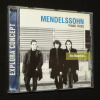



![6 Lieder pour chant et piano, avec texte allemand et traduction française de L. Delâtre, musique de Mendelssohn-Bartholdy, op. 57 [Musique imprimée]. ...](https://static.livre-rare-book.com/pictures/BRK/27136_1_thumb.jpg)
![6 Lieder pour chant et piano, avec texte allemand et traduction française de L. Delâtre, musique de Mendelssohn-Bartholdy, op. 57 [Musique imprimée]. ...](https://static.livre-rare-book.com/pictures/BRK/27136_2_thumb.jpg)
![6 Lieder pour chant et piano, avec texte allemand et traduction française de L. Delâtre, musique de Mendelssohn-Bartholdy, op. 57 [Musique imprimée]. ...](https://static.livre-rare-book.com/pictures/BRK/27136_3_thumb.jpg)



